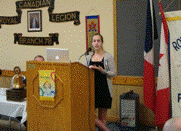In mid-February, Abby Emdin, gave an awe-inspring presentation to the Picton Rotary Club on neglected parasitic infections. Emdin’s informative presentation summarized the devastating effects of parasitic worm infections – that 600 million people worldwide are infected with worms, that 3.9 million children die annually from this cause, and that an alarming 40% of tropical disease burden is related to worms!
 Emdin is the co-founder of World Without Worms (WWW), an initiative to raise money and awareness for school based deworming programs, the first such organization in Canada. Since Grade 9, Emdin has been involved in her school’s Social Justice Club and has hosted numerous fundraisers for neglected tropical disease and global child poverty. The funds raised are transferred to their partner organization, Deworm the World, which in turn are used to transport medication and provide education to at risk areas. To date, her work has raised over $14,000, which has allowed for the treatment of 30,000 children. All money raised by WWW in 2012 will be directed to school-based deworming projects in Bihar, India.
Emdin is the co-founder of World Without Worms (WWW), an initiative to raise money and awareness for school based deworming programs, the first such organization in Canada. Since Grade 9, Emdin has been involved in her school’s Social Justice Club and has hosted numerous fundraisers for neglected tropical disease and global child poverty. The funds raised are transferred to their partner organization, Deworm the World, which in turn are used to transport medication and provide education to at risk areas. To date, her work has raised over $14,000, which has allowed for the treatment of 30,000 children. All money raised by WWW in 2012 will be directed to school-based deworming projects in Bihar, India.
Learn more about Abby Emdin, and her organization, World Without Worms here.


